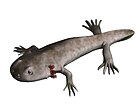Parioxys
| Parioxys Temporal range: Early Permian
| |
|---|---|
| Scientific classification | |
| Kingdom: | Animalia |
| Phylum: | Chordata |
| Class: | Amphibia |
| Order: | †Temnospondyli |
| Family: | †Parioxyidae Moustafa, 1955 |
| Genus: | †Parioxys Cope, 1878 |
| Species | |
| |
Parioxys is an extinct genus of temnospondyl amphibian from the Early Permian of Texas.
History of study[]
The type species, Parioxys ferricolus, was named in 1878 by American paleontologist Edward Drinker Cope based on two badly preserved skulls that were collected from the early Permian Texas red-beds.[1] Egyptian paleontologist, Youssef S. Moustafa, described new material of P. ferricolus from other localities in Texas.[2][3] Moustafa also described another species, P. romeri, on the basis of an isolated humerus, but this was regarded as being indeterminate. A second definitive species, P. bolli, was described by Canadian paleontologist Robert Carroll in 1964.[4] This taxon is only known from postcranial material.
Relationships[]
Parioxys was historically considered to be closely related to eryopoids, more specifically the well-known Eryops megalocephalus, which was collected from the same locality as the type material of P. ferricolus. Cope himself listed P. ferricolus as a species of Eryops,[5][6] possibly because he considered it to be a juvenile specimen of Eryops.[7] It was shortly revived as a distinct genus[8] with a suggestion that the original specimen's described by Cope might have been inadvertently described as other taxa by other authors,[9] but its affinities continued to be debated, with some suggestions that it might instead belong to the Trematopidae.[10][11] Moustafa (1955a) placed Parioxys in its own family and suggested that it was related to the Dissorophidae.[3] Schoch & Milner (2014) placed Parioxys within Dissorophidae based on personal observations of further preparation of historic material, although this has not been tested in a phylogenetic analysis due to the poor quality of much of the material.[12]
References[]
- ^ Cope, E. D. (1878). "Descriptions of Extinct Batrachia and Reptilia from the Permian Formation of Texas". Proceedings of the American Philosophical Society. 17 (101): 505–530. ISSN 0003-049X. JSTOR 982652.
- ^ Moustafa, Y.S. (1955). "The affinities of Parioxys ferricolus and the phylogeny of the 'eryopsoid'amphibians". Bulletin de l'Institut d'Égypte. 36: 77–104.
- ^ a b Moustafa, Y.S. (1955). "The skeletal structure of Parioxys ferricolus, Cope". Bulletin de l'Institut d'Égypte. 1: 41–76.
- ^ Carroll, Robert L. (1964). "The relationships of the rhachitomous amphibian Parioxys". American Museum Novitates (2167): 1–11.
- ^ Cope, E. D. (1882). "Synopsis of the Vertebrata of the Puerco Eocene epoch". Proceedings of the American Philosophical Society. 20 (112): 461–471. ISSN 0003-049X. JSTOR 982693.
- ^ Cope, E. D. (1888). "Systematic Catalogue of the Species of Vertebrata Found in the Beds of the Permian Epoch in North America with Notes and Descriptions". Transactions of the American Philosophical Society. 16 (2): 285–297. doi:10.2307/1005392. ISSN 0065-9746. JSTOR 1005392.
- ^ CASE, E. C. (2016). REVISION OF THE AMPHIBIA AND PISCES OF THE PERMIAN OF NORTH AMERICA : with a description of permian. insects by e. h. sellards, and a discussion of the. FORGOTTEN Books. ISBN 978-1-333-11391-9. OCLC 982773533.
- ^ Mehl, M. G. (1912-09-27). "A Revision of the Amphibia and Pisces of the Permian of North America". Science. 36 (926): 408–409. doi:10.1126/science.36.926.408. ISSN 0036-8075.
- ^ Watson, D. M. S. (1920-01-01). "The Structure, Evolution and Origin of the Amphibia. The "Orders' Rachitomi and Stereospondyli". Philosophical Transactions of the Royal Society B: Biological Sciences. 209 (360–371): 1–73. Bibcode:1920RSPTB.209....1W. doi:10.1098/rstb.1920.0001. ISSN 0962-8436.
- ^ Romer, Alfred S. (1936). "Studies on American Permo-Carboniferous tetrapods". Problems of Paleontology, USSR. 1: 85–93.
- ^ Romer, Alfred Sherwood (1947). Review of the labyrinthodontia. OCLC 253748351.
- ^ Schoch, Rainer R.; Milner, Andrew R. (2014). Sues, Hans-Dieter (ed.). Temnospondyli I - Handbook of Paleoherpetology Part 3A2. Stuttgart: Verlag Dr. Friedrich Pfeil. ISBN 9783899371703.
- Cisuralian temnospondyls of North America
- Prehistoric amphibian genera














